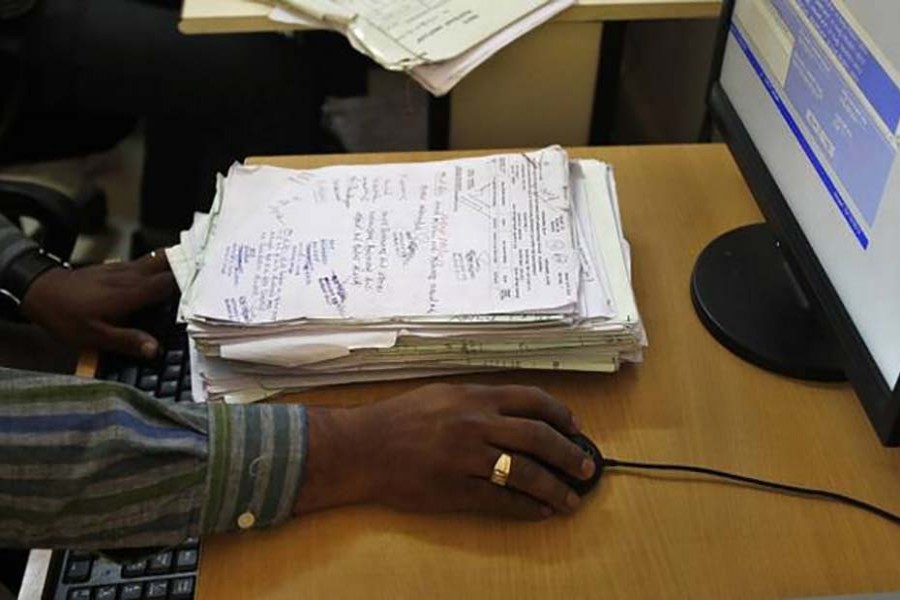Ever since the government announced its vision of Digital Bangladesh more than a decade ago, one of the key areas that needed to be brought under focus was the country's land record system. Needless to say, it is one of the most important areas of public interest requiring reform, and digitisation believed to be a sure healer of countless maladies in public functions is no doubt a fitting tool to set things right. This is primarily because land record maintenance in the country hardly ever experienced any reform since ages. The outmoded manner in which land records are kept and maintained traces its ancestry to the British colonial period, and for obvious reasons, people engaged in doing the work as custodians of age-old valuable documents are barely aware of the modern, technology-backed system that can ensure safekeeping as well as authenticity of the documents.
It is well known that the present land record management is the breeding ground of endless litigations, acerbic enmities in both urban and rural areas. It is also a hunting ground for the powerful to prevail upon the weak taking advantage of the age-old methods of record keeping susceptible to manipulation. It is because of the faulty and vulnerable system reliant on manual record keeping in ledgers and registers that a piece of land might get sold a number of times, rendering sales or purchases extremely risky. As a result, the number of land dispute cases pending with the courts all over the country is increasing every year and is believed to be much higher than in most other countries. A good deal of the problems is attributed to the cumbersome and complex system of record keeping that often makes accessing correct information more than just difficult. The victims in the process are the commoners. Hassled and tricked by touts and middlemen - products of the system over generations -- they often find themselves ripped apart.
In this connection, it may be mentioned here that in most government offices, private too, there is the practice of destroying files and papers once these are found outdated and of no use, after expiry of a certain time as per a guideline. The government offices also have earmarked spots for destroying the useless piles of papers and documents by burning them. This cannot be imagined in case of our sub-registry offices - the depository of land records, for when it comes to land records, there is nothing called old, outdated or useless. So, these offices often housed in tiny spaces, especially those in places outside the district headquarters, are crammed with heaps of papers, some as old as fifty or more years. In an atmosphere overstuffed with papers and documents in racks and roof-high dusty shelves, it is difficult to put one's mind to work. Retrieving a decade-old document may take days, even weeks, if, mercifully not lost.
Given the prevailing situation, there should not be any questioning the merits of digitisation. A local daily has recently reported that two projects taken up by the government in this regard -- one with its own resources and the other under donor funding -- have run into snags. The government in 2010 approved a project with its own funding to digitise all existing land documents, including maps, mauzas and khatians in a total of nearly 60 upazilas. But, reportedly, due to application of faulty software the project could barely have any worthwhile outcome. The other project -- Digital Land Management System project -- funded by the Asian Development Bank is currently engaged in 44 districts. But this project is also not progressing well, reportedly for delays in release of funds, and hence the time is being repeatedly extended.
This is not at all desirable. Surprisingly, in recent times, the issue is not in public discussion at all. The media, too, has apparently forgotten to pursue the matter and peruse the readers about the current state of the projects.
Today, most countries, including the developing ones, have parted with manual handling of land records. Given that it is a mammoth task and cannot be expected to be completed in a strictly time-bound manner, as it is in case of a construction project, there has to be a well planned strategy on how to go about bringing these into digital format. Reports published in the newspapers say the sub-registry offices are yet to be provided with the effective tools to start with.
Digitisation, more than anything, will do away with a lot of public sufferings. Because of the manual handling of documents and their susceptibility to manipulation, forgery and even theft, safekeeping is crucially important. This, besides easing the works of the offices dealing with land records will also provide a great relief to the people-- the perennial victims. All concerned should do their best to put things in place so as to facilitate the digitising process that, unfortunately, appears to have gone out of focus-for inexplicable reasons.
wasiahmed,[email protected]


